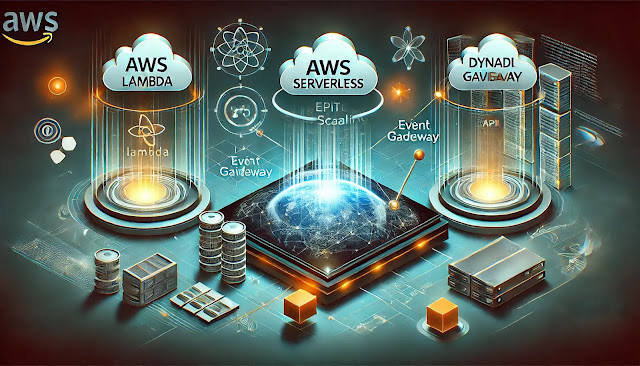Going Serverless: Maximizing Efficiency with AWS Serverless Technologies
In today's fast-paced digital landscape, businesses need to innovate quickly while keeping operational costs low. AWS serverless technologies have emerged as a powerful solution for maximizing efficiency, reducing infrastructure overhead, and allowing developers to focus on building great applications. By eliminating the need to manage servers, AWS’s serverless offerings empower organizations to scale dynamically and innovate faster. Here’s how you can leverage AWS serverless technologies to maximize efficiency and streamline your operations.
1. What is Serverless Computing?
Serverless computing allows developers to build and run applications without having to manage the underlying infrastructure. With serverless, AWS takes care of provisioning, scaling, and maintaining the servers, so you only pay for the actual compute resources used. Serverless computing is event-driven, meaning it only runs code in response to specific events, ensuring high efficiency.
2. AWS Lambda: The Heart of Serverless
At the core of AWS’s serverless architecture is AWS Lambda, a compute service that automatically runs your code in response to events. Whether it's triggered by an HTTP request, a file upload, or a change in a database, Lambda scales seamlessly with your workload. It eliminates the need for traditional server management and reduces costs by charging only for the compute time consumed. By using Lambda, businesses can build highly responsive, scalable applications without managing servers.
3. Amazon API Gateway: Efficient API Management
For modern applications, APIs are essential for enabling communication between services and devices. Amazon API Gateway allows developers to create, deploy, and manage APIs without having to provision or manage infrastructure. It integrates seamlessly with Lambda, making it easy to build scalable serverless APIs that respond to user requests in real-time. API Gateway also includes features like caching, rate limiting, and security to ensure your APIs are robust and efficient.
4. Amazon DynamoDB: Serverless Databases for High Performance
When it comes to managing large amounts of data in a serverless architecture, Amazon DynamoDB is a go-to choice. DynamoDB is a fully managed, serverless NoSQL database that scales automatically with your application’s demands. It offers low-latency performance at any scale, making it perfect for serverless applications that need high-speed access to data. Since DynamoDB is serverless, you don’t have to worry about provisioning or scaling the database—AWS handles everything.
5. AWS Fargate: Serverless Containers
For organizations that prefer to run containerized applications, AWS Fargate offers a serverless option for running containers without the need to manage underlying servers. Fargate works with both Amazon Elastic Container Service (ECS) and Amazon Elastic Kubernetes Service (EKS), enabling you to run containers at scale without worrying about the infrastructure. This allows you to focus on building and deploying containers while Fargate handles provisioning, scaling, and management.
6. Event-Driven Architectures
AWS serverless technologies are ideal for building event-driven architectures, where actions trigger events that automatically invoke the necessary services. For example, when a user uploads a file to an S3 bucket, it can trigger a Lambda function to process the file. This event-driven approach reduces the need for idle resources, ensuring your application only uses resources when needed, thus maximizing efficiency and minimizing costs.
7. Cost Optimization with Serverless
One of the key benefits of going serverless is the cost-saving potential. In traditional server-based environments, you have to pay for servers whether they are fully utilized or not. With serverless, you only pay for what you use. AWS Lambda, for example, charges based on the number of requests and compute time consumed, while DynamoDB charges are based on read and write requests. This usage-based pricing ensures you never overpay for unused resources, making serverless a highly cost-efficient choice for businesses of all sizes.
8. Scaling Seamlessly with Serverless
One of the most significant advantages of AWS serverless technologies is their ability to scale automatically with your application’s demand. Whether you’re handling a few requests per minute or thousands per second, services like Lambda, DynamoDB, and API Gateway scale seamlessly without any intervention. This eliminates the need to manually provision or manage additional resources, allowing your team to focus on building features rather than scaling infrastructure.
9. Security and Compliance in Serverless Architectures
Security is a top priority for any cloud-based application, and AWS ensures that serverless applications are secure by default. AWS takes care of infrastructure security, while developers remain responsible for securing their code and data. AWS services like AWS Identity and Access Management (IAM) and AWS Key Management Service (KMS) provide robust security features, including fine-grained access control and encryption for serverless applications.
Conclusion
Going serverless with AWS offers businesses a powerful way to maximize efficiency, reduce operational overhead, and accelerate innovation. By leveraging AWS Lambda, API Gateway, DynamoDB, and other serverless technologies, organizations can build scalable, cost-effective applications without the burden of managing servers. In a world where speed and agility are critical to success, serverless computing empowers teams to focus on delivering value to customers while AWS handles the heavy lifting behind the scenes.





0 Comments